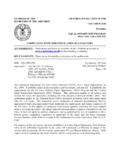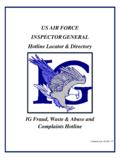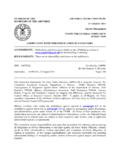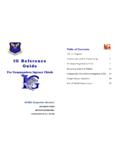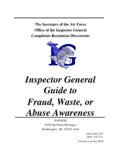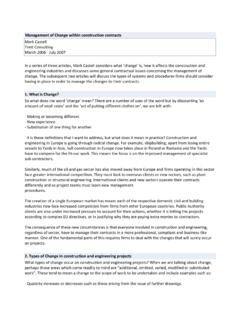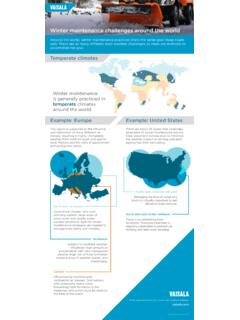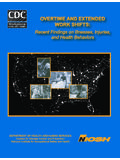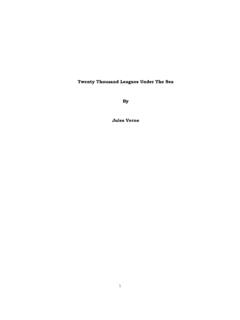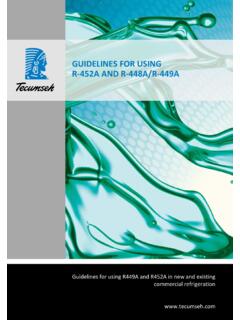Transcription of THE DEPARTMENT OF THE AIR FORCE ARCTIC STRATEGY - AF
1 IENSURING A STABLE ARCTIC THROUGH VIGILANCE, POWER PROJECTION, COOPERATION, AND PREPARATIONTHE DEPARTMENT OF THE AIR FORCEARCTIC STRATEGYii12 The DEPARTMENT of the Air FORCE ARCTIC STRATEGY The DEPARTMENT of the Air FORCE ARCTIC STRATEGY fully supports the 2018 National Defense STRATEGY (NDS) and implements the 2019 DEPARTMENT of Defense (DoD) ARCTIC STRATEGY embracing the DoD s desired ARCTIC end-state: A secure and stable region where national interests are safeguarded, the homeland is protected, and nations address shared challenges STRATEGY outlines the DEPARTMENT of the Air FORCE s unique role and optimizes Air FORCE and Space FORCE capabilities for the region. The ARCTIC s increasing strategic importance, coupled with the Services significant regional investment, requires the DEPARTMENT to have a unified, deliberate, and forward-looking approach, ensuring the Air and Space Forces can compete and defend the nation s interests in the ARCTIC at the intersection between the homeland and two critical theaters, Indo-Pacific and europe , the ARCTIC is an increasingly vital region for national security interests.
2 The ARCTIC s capacity as a strategic buffer is eroding, making it an avenue of threat to the homeland, due to advancements by great power competitors. Additionally, it hosts critical launch points for global power projection and increasingly accessible natural resources. While the DoD analyzes the immediate prospect of conflict in the ARCTIC as low,1 the confluence of activities in the region by great power competitors with increased physical access due to receding land ice and sea ice, yields the potential for intensified regional competition as well as opportunities for cooperative endeavors with allies and DEPARTMENT of the Air FORCE contributions to national security in the ARCTIC are large, but relatively unknown. Given the ARCTIC s vast distances and challenges to surface operations, air and space capabilities have long been essential to gain rapid access and provide all-domain awareness, early warning, satellite command and control, and effective deterrence.
3 Offering a solid foundation on which to build and project power across the region, the DEPARTMENT of the Air FORCE is the most active and invested military DEPARTMENT in the STRATEGY identifies the ARCTIC as a region of strategic opportunity for the Air and Space Forces, Joint FORCE , allies, and partners. It provides recommendations in light of the ARCTIC s most significant strategic threats and opportunities, based on Combatant Commander requirements and the Air and Space Forces missions. The DEPARTMENT approaches the ARCTIC with four main lines of effort: Vigilance, Power Projection, Cooperation, and Preparation. The STRATEGY outlines how the Air and Space Forces will organize, train, and equip to provide Combatant Commanders with combat-credible assets capable of conducting operations throughout the ARCTIC into the future.
4 1. DoD Report to Congress: ARCTIC STRATEGY DoD Report to Congress: Resourcing the ARCTIC STRATEGY Summary3 First, through investments in missile warning and defense, as well as command, control, communications, intelligence, surveillance, and reconnaissance (C3 ISR), the Air and Space Forces will defend the homeland by maintaining , the Air and Space Forces will utilize unique positioning afforded by bases in locations like Alaska and Greenland to project combat-credible, all-domain air and space power. Infrastructure, focused on thermal efficiency and durability, will be combined with fifth generation aircraft and lethal capabilities to ensure the Air and Space Forces remain agile and capable in the , strong alliances and partnerships in the ARCTIC are a strategic advantage for the United States.
5 The STRATEGY outlines ways to enhance cooperation as well as interoperability, operations, and exercises between the United States and its ARCTIC partners. To uphold the international rules-based order in the ARCTIC , the Air and Space Forces must leverage the strong defense relationships among ARCTIC nations and work closely with regional and joint , the STRATEGY outlines essential training and preparation for operations within this unique environment. To meet this challenge, the DEPARTMENT will renew focus on training, research, and development for ARCTIC operations, while leveraging the ARCTIC expertise of the Total Air & Space Forces in the ArcticThe ARCTIC represents a cornerstone of the nation s defense. The DEPARTMENT of the Air FORCE provides close to 80% of DoD resourcing to the ARCTIC Installations across Alaska, Canada, and Greenland include large bases, training complexes, satellite command and control stations, and a constellation of more than 50 early warning and missile defense radars.
6 For reference, page 5 highlights DEPARTMENT of the Air FORCE ARCTIC , the ARCTIC region consists of the ARCTIC Ocean, adjacent seas, and parts of eight nations: Canada, the Kingdom of Denmark (including Greenland), Finland, Iceland, Norway, Russia, Sweden, and the United Demographically, among the millions of ARCTIC inhabitants, indigenous communities possess millennia of knowledge about the ARCTIC domain passed down through generations. Several factors make the ARCTIC particularly reliant on air, space, and cyberspace power to provide rapid access, reach, and domain awareness. The area above the ARCTIC Circle (above 66 degrees North latitude) is vast, almost times the size of the continental United States. Lacking the climate-moderating effect of the warm Gulf Stream, the North American ARCTIC hosts a much harsher environment than the European ARCTIC and significantly less road and maritime infrastructure.
7 Alaska epitomizes this geographical disparity in infrastructure. It is the largest state (twice the size of Texas) covering 586,000 square miles, but offering only 5,600 miles of ARCTIC is a region of immense geostrategic significance and a key location for global power projection. With two large Alaska air bases, Joint Base Elmendorf-Richardson and Eielson Air FORCE Base (AFB), and other strategic facilities, the Air and Space Forces project power into two critical theaters: Indo-Pacific and europe . Often unrecognized, Alaska offers the quickest flight access to strategic locations across the Pacific region and western Russia. As evidence of Alaska s strategic location, once the planned F-35 bed-down is complete, Alaska will be home to more advanced fighters than any other location in the strategic as the ARCTIC is to power projection, it is equally critical to deterrence and defense.
8 From an air and space power perspective, it is the shortest distance for adversaries to threaten the homeland with strategic air and missile attacks. The Alaska Radar System and the 50-plus radars that comprise the North Warning System across Canada provide vital early warning for homeland defense and North American Aerospace Defense Command (NORAD). Locations like clear , Alaska and Thule, Greenland uniquely enable missile warning and defense in addition to space domain awareness, helping USSPACECOM track tens of thousands of objects daily. From aerial refueling tankers to the Air National Guard s ski-equipped aircraft, the Air FORCE brings mobility capabilities that provide access to some of the harshest and most remote locations in the ARCTIC . Meanwhile the Alaska Rescue Coordination Center and affiliated rescue squadrons work closely with partners, including the Coast Guard, on hundreds of search and rescue missions DoD Report to Congress: Resourcing the ARCTIC STRATEGY 2016.
9 4. The DEPARTMENT of the Air FORCE ARCTIC STRATEGY uses the definition of the ARCTIC codified at 15 4111. The ARCTIC means all and foreign territory north of the ARCTIC Circle and all territory north and west of the boundary formed by the Porcupine, Yukon, and Kuskokwim Rivers; all contiguous seas, including the ARCTIC Ocean and the Beaufort, Bering, and Chukchi Seas; and the Aleutian Islands Alaska DEPARTMENT of Transportation & Public Facilities. DEPARTMENT Fast Facts Prepared for Legislative Session of the Air FORCE Equities in the ArcticUSAF EQUITIES IN THE ARCTICDAF is responsible for of DoD ARCTIC Resourcing Source: 2016 DoD Report to Congres sUNITED STATESSAMPLE OF ARCTIC REGION MILITARY FACILITIESCANADANORWAYRUSSIADENMARK/GREE NLANDALASKACANADAGREENLANDSWEDENFINLANDI CELANDB arrow & North Warning SystemJBER & Alaska RescueCoordination CenterEarecksonASRavenCampEielson AFB, clear AFS, JPARCN orth Warning SystemThuleAB79% Map Source: National Geospatial-Intelligence AgencyJOINT BASE ELMENDORF-RICHARDSON (JBER):F-22, E-3, C-17, C-130, C-12F, Alaska Rescue Coordination Center: HC-130, HH-60 EIELSON AFB: F-35, F-16, ANG KC-135, Polar Survival School JOINT PACIFIC ALASKA RANGE COMPLEX (JP ARC): Airspace & Training GroundsCLEAR AFS.
10 Ballistic Missile Early Warning, Space Domain AwarenessPOINT BARROW/NORTH SLOPE: Alaska Radar System (15 radars, 3 part of North Warning System)EARECKSON AS: Missile Defense RadarNORAD: North Warning System (~50 radars)THULE AB: Ballistic Missile Early Warning, Space Domain AwarenessRAVEN CAMP: ANG Training for LC-130 USAF EQUITIES IN THE ARCTICDAF is responsible for of DoD ARCTIC Resourcing Source: 2016 DoD Report to Congres sUNITED STATESSAMPLE OF ARCTIC REGION MILITARY FACILITIESCANADANORWAYRUSSIADENMARK/GREE NLANDALASKACANADAGREENLANDSWEDENFINLANDI CELANDB arrow & North Warning SystemJBER & Alaska RescueCoordination CenterEarecksonASRavenCampEielson AFB, clear AFS, JPARCN orth Warning SystemThuleAB79% Map Source: National Geospatial-Intelligence AgencyJOINT BASE ELMENDORF-RICHARDSON (JBER):F-22, E-3, C-17, C-130, C-12F, Alaska Rescue Coordination Center: HC-130, HH-60 EIELSON AFB: F-35, F-16, ANG KC-135, Polar Survival School JOINT PACIFIC ALASKA RANGE COMPLEX (JP ARC): Airspace & Training GroundsCLEAR AFS: Ballistic Missile Early Warning, Space Domain AwarenessPOINT BARROW/NORTH SLOPE: Alaska Radar System (15 radars, 3 part of North Warning System)EARECKSON AS: Missile Defense RadarNORAD: North Warning System (~50 radars)THULE AB: Ballistic Missile Early Warning, Space Domain AwarenessRAVEN CAMP: ANG Training for LC-130 USAF EQUITIES IN THE ARCTICDAF is responsible for of DoD ARCTIC Resourcing Source.
